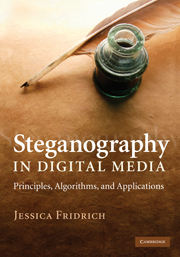Book contents
- Frontmatter
- Dedication
- Contents
- Preface
- Acknowledgments
- 1 Introduction
- 2 Digital image formats
- 3 Digital image acquisition
- 4 Steganographic channel
- 5 Naive steganography
- 6 Steganographic security
- 7 Practical steganographic methods
- 8 Matrix embedding
- 9 Non-shared selection channel
- 10 Steganalysis
- 11 Selected targeted attacks
- 12 Blind steganalysis
- 13 Steganographic capacity
- A Statistics
- B Information theory
- C Linear codes
- D Signal detection and estimation
- E Support vector machines
- Notation and symbols
- Glossary
- References
- Index
- Plate section
Preface
Published online by Cambridge University Press: 05 April 2014
- Frontmatter
- Dedication
- Contents
- Preface
- Acknowledgments
- 1 Introduction
- 2 Digital image formats
- 3 Digital image acquisition
- 4 Steganographic channel
- 5 Naive steganography
- 6 Steganographic security
- 7 Practical steganographic methods
- 8 Matrix embedding
- 9 Non-shared selection channel
- 10 Steganalysis
- 11 Selected targeted attacks
- 12 Blind steganalysis
- 13 Steganographic capacity
- A Statistics
- B Information theory
- C Linear codes
- D Signal detection and estimation
- E Support vector machines
- Notation and symbols
- Glossary
- References
- Index
- Plate section
Summary
Steganography is another term for covert communication. It works by hiding messages in inconspicuous objects that are then sent to the intended recipient. The most important requirement of any steganographic system is that it should be impossible for an eavesdropper to distinguish between ordinary objects and objects that contain secret data.
Steganography in its modern form is relatively young. Until the early 1990s, this unusual mode of secret communication was used only by spies. At that time, it was hardly a research discipline because the methods were a mere collection of clever tricks with little or no theoretical basis that would allow steganography to evolve in the manner we see today. With the subsequent spontaneous transition of communication from analog to digital, this ancient field experienced an explosive rejuvenation. Hiding messages in electronic documents for the purpose of covert communication seemed easy enough to those with some background in computer programming. Soon, steganographic applications appeared on the Internet, giving the masses the ability to hide files in digital images, audio, or text. At the same time, steganography caught the attention of researchers and quickly developed into a rigorous discipline. With it, steganography came to the forefront of discussions at professional meetings, such as the Electronic Imaging meetings annually organized by the SPIE in San Jose, the IEEE International Conference on Image Processing (ICIP), and the ACM Multimedia and Security Workshop. In 1996, the first Information Hiding Workshop took place in Cambridge and this series of workshops has since become the premium annual meeting place to present the latest advancements in theory and applications of data hiding.
- Type
- Chapter
- Information
- Steganography in Digital MediaPrinciples, Algorithms, and Applications, pp. xv - xxiiPublisher: Cambridge University PressPrint publication year: 2009



